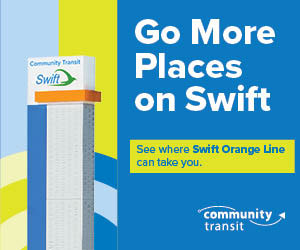By Erin Freeman | Lynnwood Times Staff
Following the COVID-19 pandemic, the city of Lynnwood is mystified by the whereabouts of unsheltered people experiencing homelessness throughout Snohomish County.
“There’s been a precipitous decrease across the county in the count of homeless people we’re seeing at the encampment sites- a drastic decrease, and frankly we’re a little unsure as to where all these people went,” said Lynnwood Police Commander Chuck Steichen. “Again, we’re not sure where everyone went and we’re trying to determine that now.”
The observations in the city of Lynnwood carry throughout the entirety of Snohomish County. Snohomish County’s SnoCo Agencies for Engagement (SAFE) Team, the group of law enforcement officers, social workers, and healthcare professionals who conduct outreach and health assessments in the wake of COVID-19, were surprised to find a less than forecasted number of people frequenting encampments.
At the end of January, Snohomish County’s Human Services Housing and Community Services Department conducted an annual Point-in-Time count report, a calculation of the sheltered and unsheltered population, identifying 1,100 people experiencing homelessness residing across the county.
According to the United States Department of Housing and Urban Development (HUD), the term “unsheltered” refers to a segment of the homeless community residing “in a place not meant for human habitation, such as cars, parks, sidewalks, abandoned buildings (on the street)”. HUD’s definition of “sheltered” are those residing in an emergency shelter or “in transitional housing or supportive housing for homeless persons who originally came from the streets or emergency shelters.”
Snohomish County’s Point-in-Time count webpage states that “while it is not possible to count every homeless person, the methodology includes outreach efforts targeting known areas and general canvassing to capture the best picture possible.”
After the data identified by the annual Point-in-Time count report is analyzed, it is used to inform the Snohomish County Continuum of Care Plan for addressing the immediate and existing needs of the homeless population, including the direction of allocated resources during the coronavirus pandemic.
The SAFE team’s efforts were designed and coordinated regarding the county’s observations of the unsheltered populations’ patterns at encampments and throughout the city, but as of May 4, they have only been able to locate 221 unsheltered individuals in camp or street settings.
Snohomish County Senior Executive Analyst Alessandra Durham, who supported the coordination of SAFE Team’s COVID-19 prevention efforts, believes the seemingly severe decline in the observable unsheltered population is attributed specifically to the decrease in visibility posed by COVID-19 precautions.
“I don’t think that we’ve seen a drastic decline or that people have gone missing. I think that they’re in an environment we aren’t aware of at the moment,” she stated. “Our law enforcement teams, and social workers are not operating the way that they typically do when we’re not in a pandemic, and so they don’t have updated ideas of where people are staying.”
Durham says that although the team was surprised to have only located a small portion of the county’s reported unsheltered population, it’s not uncommon for migration patterns to change based upon situational and environmental necessities.
“It’s not uncommon that people will move around… we are typically just more aware of where, because we have teams on the ground,” explained Durham. “What we’re hearing from the SAFE team, is that as the pandemic has gone on, people have found different living environments to be in.”
On March 17 the county, Providence Institute for a Healthier Community (PIHC) and the Community Foundation of Snohomish County (CFSC) announced a joint effort to provide motel/hotel vouchers to individuals and homeless households on the countywide coordinated entry list, along with others currently experiencing homelessness.
“This expanded sheltering capacity is helping Snohomish County and our partners provide more safe places for vulnerable community members during this challenging time while also reducing risk for residents throughout our county,” said Director of Snohomish County Human Services MaryJane Brell Vujovic in a press release.
Within one month, approximately 300 previously unsheltered and sheltered people have accessed temporary housing through the motel/hotel vouchers and at the Carnegie Resource Center, according to a Snohomish County press release announcing the SAFE Team on April 17.
“At the beginning of this pandemic, we did allocate funding to hotel and motel vouchers and since then on any given night, we’re seeing 300 individuals that are in the hotels or motels,” explained Durham. “Those are 300 unduplicated people cycling in and out depending on their ability to find housing elsewhere.”
In an attempt to trace the county’s remaining homeless population, the Department of Emergency Management and the Snohomish Health District contacted neighboring counties to see if they’ve noticed a respective increase of people in their shelters and encampment locations.
“We did reach out [to Skagit County and King County], just to ensure that our residents were not going into other counties, and both reported that they haven’t seen a significant uptake,” stated Durham. “This indicates that the rumors that our folks are moving to King County or Skagit are not likely to be true.”
Members of the homeless population who have not been verified utilizing Snohomish County’s existing encampments, hotel/motel vouchers, or inhabiting additional temporary housing arrangements may have developed new undiscovered encampments. The unsheltered populations’ patterns of movement may also be associated with efforts to social distance.
“When we talked to people experiencing homelessness, they are very well aware of COVID-19 and social distancing,” explained Durham. “They might be distancing themselves from one another.”
The SAFE Team has performed walk-throughs of the county’s forested areas in search of people experiencing homelessness but have not specifically focused on public parks because there hasn’t been a reported “upsweep at the parks of people experiencing homelessness,” according to Durham.
To conduct an increased targeted outreach to the homeless population, the SAFE Team plans to work with homeless service providers and are in discussion to potentially collaborate with Community Transit to conduct support and resource access to those continuing to utilize their transportation services.
“The people are here, we just need to find them and that’s what we’re going to do,” stated Durham.
To connect someone experiencing homelessness to support or resources during COVID-19, call 2-1-1 for help.








